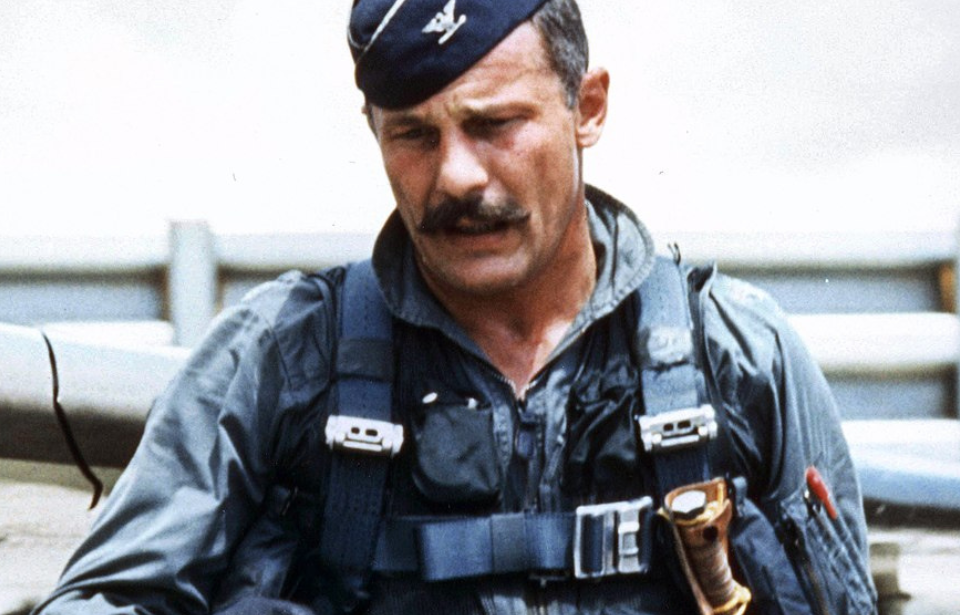Fighter pilot
Triple ace
Robin Olds, born in 1922, was a legendary American fighter pilot and Air Force general. A triple ace with 17 aerial victories across World War II and Vietnam, Olds epitomized the bold, innovative fighter pilot. He flew P-38s and P-51s in WWII, becoming an ace at just 22. After the war, Olds transitioned to jets and served in various leadership roles. In Vietnam, he commanded the 8th Tactical Fighter Wing, masterminding Operation Bolo, a successful MiG ambush. Known for his tactical brilliance and assertive personality, Olds advocated for improved conventional air warfare capabilities. He retired as a brigadier general in 1973, leaving an indelible mark on U.S. Air Force history. Below is a dramatic excerpt from his book—Fighter Pilot—which makes for incredible reading!
P-38s as far as the eye could see…
What an absolutely wonderful sight from my cockpit: P-38s stretched as far as the eye could see off toward the right horizon, the morning sky deep blue and not a cloud anywhere. It was a great day to be a fighter pilot!
We crossed the coast of Holland and saw a few haphazard puffs of flak from IJmuiden burst below us. This was routine. We would have felt unwel- come if those particular gunners hadn't noticed our passage. We flew on across the Zuiderzee, and then the prominent peninsula on the eastern shore with the town of Urk at its tip slid beneath us.
Things tensed up as we flew over the patchwork fields and canals of central Holland. No flak. Everything was ominously quiet. Things were way too still. Then on into Germany, and my mind was working on two distinct levels: The predominant one was intensely alert, watching, analyzing, gauging, totally tuned to the sky, the land, and the aircraft around me. The subordinate part was more at ease, aware of the situation, yet free to enjoy the beauty, power, a serenity surrounding me.
Suddenly, there they were! Tiny specks way out in front moved right to left across our horizon. The hair on the back of my neck stood straight out. No problem of recognition—I knew they were the enemy. Many more of them were seen as a few seconds passed. I delayed a few seconds calling them out—a dirty trick on my part. My intentions were thwarted just as I started to call Highway. One of my flight members saw them and yelled out, “Bogeys. Eleven o'clock. Level!” I confess I mashed down on the mike button to block any further conversation, and then called, “Newcross Lead, Newcross Blue Lead here. Turning left to pursue and identify.”
The air became a confusion of transmissions, most not decipherable, some broken: “... Say again direction ... Blue, what's your heading? What's your heading?... I haven't got them yet.... Blue where are you?”
Blue knew exactly where he was. He was balls out, full throttle, max boost, full rich mixture, closing on the tail end of some forty-five to fifty Me-109s flying in a ragged formation of three big Vs of about fifteen aircraft each, with a few singles above and behind. These last ones bothered me. Common sense said to attack them first. Instinct told me to continue, keep an eye on them, but break off my attack only if they saw me and made a threatening move.
Dead stick!
Suddenly, I remembered my drop tanks and hit the pickle button. Away they went with the usual thump, and I felt my P-38 surge forward from the reduced drag. I looked over my shoulders for my flight members. B.E. was right there with me, but the other two were far back, both trailing black smoke as their engines detonated under the strain of overboost. I knew they couldn’t catch up and that the initial part of this fight was going to be two against the world.
“Newcross Blue Lead, Highway here. What's your position?” Zemke called.
That wasn't a question. It was a demand. How in hell did I know where I was? There was a huge lake just ahead and I blurted out, “I'm approaching a big lake, headed north, 28,000.” That would surely merit an ass chewing when (or if) I got back. We were supposed to know where we were at all times under Hub's leadership. Then I remembered what I was supposed to be doing for the boss, and added, “I'm closing on a gaggle of bandits headed north, about fifty of them.”
There were more confused shouts as the rest of the group tried to focus on the action. I had to ignore the bedlam and concentrate on my own situation. The few bandit trailers at my three o'clock hadn't noticed us yet, and I pressed on, zeroing in on the tail-end Charlie in the high Vick. He filled my gun sight with a slight angle off. Perfect. Just as I started to squeeze the trigger, both of my engines sputtered, chugged, burped, and quit. Good God, I had forgotten to switch to internal tanks after getting rid of the drops! I'm a glider!
No time to sort that out now. I clamped on the trigger. As I slowed and started to fall behind there were bright flashes along the fuselage of the 109; my bullets had struck home. A piece of cowling blew back in my face, black smoke spewed forth, and the 109 rolled slowly to the right and headed down. He was finished, and I had other problems. I dove away to my right, desperately working the tank switches, going through the start procedures and watching the high bandits all at the same time. The engines caught and I was back in business. It occurred to me that I was probably the first fighter pilot to shoot down an enemy while in the dead-stick mode, but fascinating as that realization was, there were some forty-nine other bandits out there.




